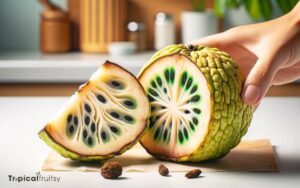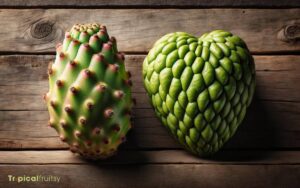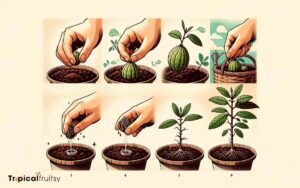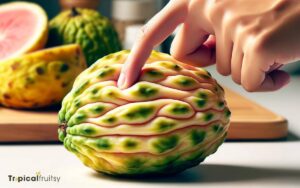How to Ripen a Cherimoya
To ripen a cherimoya effectively, you can employ a simple method involving common household fruits. Place the cherimoya in a paper bag alongside a banana or an apple, which emit ethylene gas, facilitating the ripening process.
Monitor the cherimoya’s progress by checking its firmness daily; when it slightly yields to pressure, it is ripe and ready to eat.
Upon reaching the perfect ripeness, store the cherimoya in the refrigerator to preserve its taste and texture for a few days.
Cherimoya ripening is accelerated by ethylene, a natural hormone produced by fruits such as apples and bananas.
The closed environment of a paper bag concentrates the gas around the cherimoya, speeding up the ripening process.
Here’s how to do it:
Refrigerating a ripe cherimoya can maintain its delightful taste and creamy texture for additional enjoyment over several days.
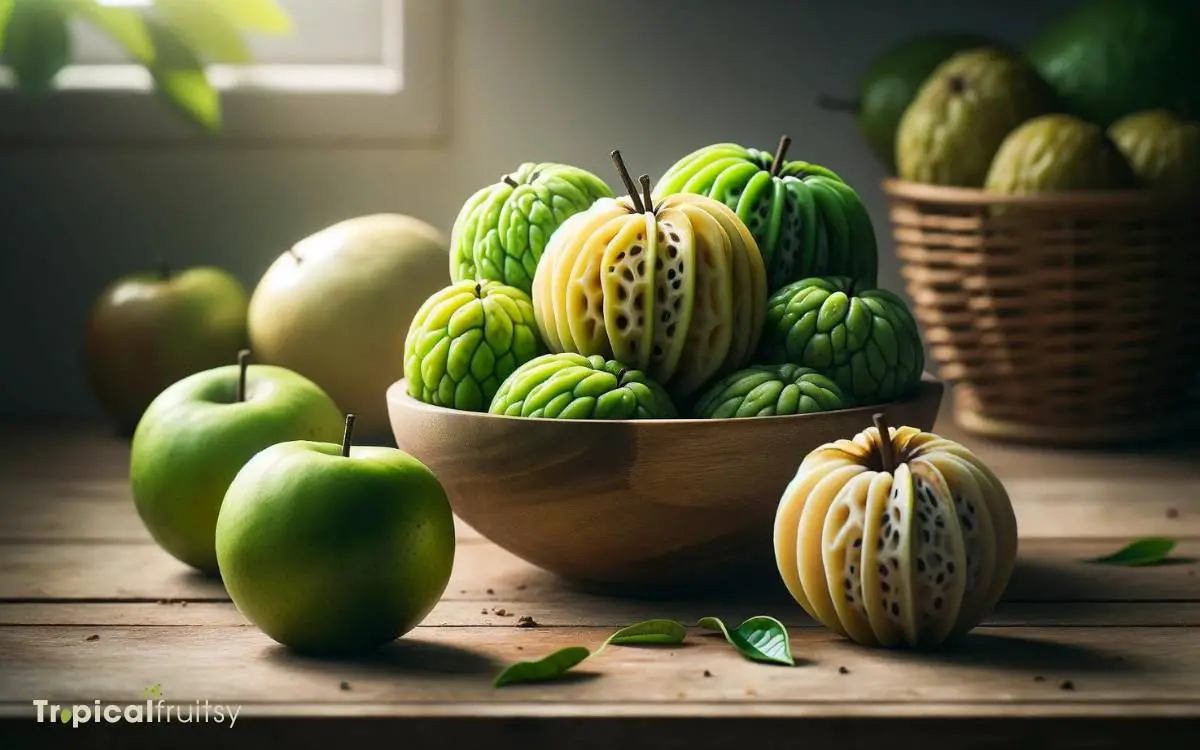
Key Takeaway
Understanding Cherimoya Ripeness
A cherimoya’s ripeness is essential for enjoying its creamy texture and tropical flavor to the fullest. Identifying the optimal stage of ripeness involves assessing the fruit’s external color and tactile cues.
A mature cherimoya typically exhibits a greenish-brown hue with a slight give upon gentle pressure.
It’s important to note that a cherimoya shouldn’t be overly soft or exhibit dark spots, as these signs indicate overripeness, which may compromise the fruit’s quality.
The skin, when ripe, often shows a yielding nature to touch without being mushy. Scientists measure ripeness using a penetrometer to quantify firmness, ensuring precision in ripeness detection.
For the consumer, the nose also offers a reliable tool; a fragrant, sweet aroma emanates from a ripe cherimoya, signaling it’s ready to be savored.
Selecting the Right Environment
Before ripening a cherimoya, it’s crucial to choose an environment that’s warm and free from drafts to facilitate the process. The ideal temperature range for ripening this fruit lies between 68 to 77 degrees Fahrenheit (20 to 25 degrees Celsius).
Humidity levels should remain moderate, as excessive moisture can encourage mold growth, while too dry conditions may cause the fruit to dehydrate and harden.
An environment with stable temperature control, such as a kitchen countertop away from windows and not directly under air vents, proves most effective.
Direct sunlight should be avoided, as it can lead to uneven ripening. By maintaining these environmental parameters, one ensures that the cherimoya ripens uniformly, achieving the optimal texture and flavor profile desired by consumers.
Using Ethylene for Ripening
One can expedite the ripening of a cherimoya by leveraging the natural plant hormone ethylene, which fruits emit as they mature.
This process is both scientifically fascinating and practically useful for those looking to enjoy their cherimoya at its peak flavor and texture.
Ethylene acts as a signaling molecule, triggering a cascade of biochemical events that lead to ripening.
- Place the cherimoya in a paper bag: Enclosing the fruit in a bag concentrates the ethylene gas around it, enhancing the ripening process.
- Add ethylene-producing fruits: Include an apple or banana in the bag, as these fruits release higher levels of ethylene, further stimulating the cherimoya.
- Monitor temperature and humidity: Keep the bag at room temperature, avoiding excessive moisture that could cause spoilage.
Monitoring the Ripening Progress
To effectively gauge the ripeness of a cherimoya, regularly check its firmness and look for a slight give under gentle pressure. As the fruit matures, its hard exterior begins to soften, which indicates progression towards optimal ripeness.
Enthusiasts should perform daily assessments by applying minor pressure with their fingers. A ripe cherimoya will yield slightly to this pressure, similar to a ripe avocado.
Additionally, observe the skin color, which transitions from vibrant green to a more muted hue as ripening occurs. It’s crucial to note any brown spots that emerge, as they often signal over-ripeness.
Monitoring the cherimoya’s aroma is also informative; a fruity, sweet scent increases in intensity as the fruit reaches peak ripeness. The process demands attentiveness to prevent the cherimoya from surpassing its prime.
Storing Ripe Cherimoyas Safely
Upon achieving optimal ripeness, cherimoyas should be stored in a cool, dark place to maintain their quality and extend shelf life. The storing environment must be carefully controlled to prevent overripening or spoilage.
Here are key considerations for safe storage:
- Temperature: Keep cherimoyas at a consistent temperature between 55°F to 60°F (13°C to 15°C).
- Humidity: Aim for moderate humidity levels to avoid dehydration of the fruit.
- Separation: Store cherimoyas away from other fruits to prevent accelerated ripening due to ethylene gas exposure.
Ensuring these conditions are met not only preserves the delicate flavors and textures of cherimoyas but also maximizes their post-ripening viability, allowing consumers to fully enjoy the tropical fruit at its peak quality.
Conclusion
In the dance of cherimoya ripening, patience waltzes with precision. One must master the art of environment selection, ethylene application, and vigilant monitoring to ensure the fruit’s perfect maturity.
The ripeness of cherimoya, a delicate interplay between time and technique, demands an analytical eye. As ripe cherimoyas rest, their storage is a silent guardian against decay.
Thus, the careful custodian of cherimoya reaps the sweet rewards of their meticulous cultivation.


